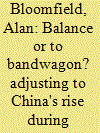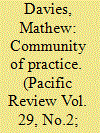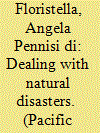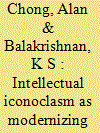|
|
|
Sort Order |
|
|
|
Items / Page
|
|
|
|
|
|
|
| Srl | Item |
| 1 |
ID:
144533


|
|
|
|
|
| Summary/Abstract |
This article examines Australian grand strategy in the context of China's rise during the period of Labor governments between 2007 and 2013. Australia's grand-strategic posture is treated as the dependent variable, plotted along a balancing-to-bandwagoning continuum. Australia remained within the hedging zone throughout, although there were discernible shifts in posture during the period. While momentum was building towards a more overt balancing posture during the Kevin Rudd era, the various balancing and bandwagoning ‘signals’ were more contradictory after Julia Gillard unseated Rudd 2010; in short, she stabilised Australia's grand-strategic posture, meaning it remains best characterized as ‘dominance denial’.
|
|
|
|
|
|
|
|
|
|
|
|
|
|
|
|
| 2 |
ID:
144531


|
|
|
|
|
| Summary/Abstract |
Despite change in the aims, institutions and informal diplomacy of ASEAN since 1997, the formal diplomatic code of conduct remains locked in a traditionalist mode first outlined in the 1970s. Existing approaches from mainstream International Relations theorising are unable to adequately explain this continuity and change. The recent ‘practice turn’ in theorising offers distinct explanatory advantage, which this article illustrates by arguing that the formation of an ‘ASEAN rationality’ between 1967 and 1997 fundamentally curtailed the ability of regional diplomats to revise ASEAN post 1997, resulting in the coexistence of new and old norms in ASEAN's organisation design.
|
|
|
|
|
|
|
|
|
|
|
|
|
|
|
|
| 3 |
ID:
144535


|
|
|
|
|
| Summary/Abstract |
Over the past two decades, natural disasters have severely hit the Southeast Asian region causing dramatic environmental, economic and social consequences. Through the lens of Beck's risk society framework and the theory of reflexive modernization, this article attempts at empirically taking stock of how the Association of Southeast Asian Nations (ASEAN) is addressing disaster risk through the creation of new regional institutions and mechanisms. In particular, it argues that the accumulation of the experience of catastrophes is leading ASEAN members towards the development of new precautionary initiatives to deal with disasters, and to forge a new way forward for the promotion of disaster cooperation and joint emergency response. The article is divided into five sections, which will only consider initiatives endorsed within the ASEAN framework. The first introduces risk societies as forms of modern societies and of the insecurities of the present world. In the second section attention is drawn to natural disasters as a paradigmatic example of Beck's risk society. The third section explores how ASEAN normative governance is evolving to include the issue of disaster management within its security and social agenda. Then the main institutional and operational innovations and tools through which ASEAN is preparing to deal with disaster risk are explored. Finally, the article suggests that despite ASEAN overall institutional innovations, the practice of cooperation still is effected by several factors, above all the lack of adequate resources and the difficulty of reconciling principles of solidarity with national sovereignty, which hinder ASEAN effectiveness in this area.
|
|
|
|
|
|
|
|
|
|
|
|
|
|
|
|
| 4 |
ID:
144532


|
|
|
|
|
| Summary/Abstract |
This article attempts to engage in a preliminary twinned study of the foreign policy styles of Mahathir bin Mohamad and Lee Kuan Yew within the framework of ‘modernizing Southeast Asian foreign policies’. Modernization is a process of immense multidimensional displacement in economy, society, political system, attitudes towards politicians, identities, work, and consumption. As such the onus falls upon their leaders to either mitigate change or productively awaken their followers to embrace a new mode of thought. Both Lee and Mahathir have however chosen to engage in the foreign policy of intellectual iconoclasm featuring the narrative of ‘productive shock’, manufactured nationalist logics, elitist policy-making and elaborate self-propaganda.
|
|
|
|
|
|
|
|
|
|
|
|
|
|
|
|
| 5 |
ID:
144528


|
|
|
|
|
| Summary/Abstract |
A territorial dispute over the Senkaku/Diaoyu islands has gained a high profile in Sino–Japanese relations. Since the 2012 escalation of the territorial dispute, there is no sign of any de-escalation despite economic interdependence, which previously helped ease the tension. Drawing on the constructivist understanding of threat perception and power transition theory, this article analyzes the way in which the deepening of threat perceptions associated with a perceived regional power transition prevents Japan and China from working beyond their subjective conceptions of justice associated with boarders and history. Since 2012, the Sino–Japanese territorial dispute has increasingly fitted into a larger picture of power-political conflict taking place in a power transition in which both Japan and China aim to return to ‘normality’ by propagating their territorial claims, strengthening their military capabilities, and strategic realignment. To that end, this article first introduces a theoretical framework on the centrality of threat perceptions in power transition. Second, it traces the ways in which Japan and China have developed a threat perception of each other since 1972. The third section deals with the escalation of the Sino–Japanese territorial dispute since 2010 and highlights the deepening of mutual suspicion and threat perception exemplified at the bilateral and multilateral levels. I conclude that the Sino–Japanese territorial debate entered a new stage of normative and power-political competition in earning international support for territorial claims in the East China Sea.
|
|
|
|
|
|
|
|
|
|
|
|
|
|
|
|
| 6 |
ID:
144530


|
|
|
|
|
| Summary/Abstract |
South Korea aspires to a larger regional and global role, fuelled by economic success, and complemented by cultural and diplomatic achievement. However, a gap exists between the rhetoric and reality of its foreign policy. This paper examines Seoul's middle-power activism. It poses questions about the conceptual deficit of ‘middle power’, proffering an operational definition in illuminating the characteristic identity formation of middle powers. It analyses how the Roh Moo-hyun and Lee Myung-bak governments sought to articulate their respective middle-power foreign policy aspirations. Finally, it investigates how domestic political and institutional conditions shape Republic of Korea foreign policy, and identifies policy implications.
|
|
|
|
|
|
|
|
|
|
|
|
|
|
|
|
| 7 |
ID:
144527


|
|
|
|
|
| Summary/Abstract |
Through an examination of East Asian economies, this paper proposes two new capitalist ideal types: family market economies and state market economies. In contrast to coordinated and liberal market economy types, the new capitalist ideal types proposed here display alternative forms of hierarchical coordination. These ideal types are also genuinely novel models of capitalism because they exhibit distinct and stable institutional structures and comparative advantages.
|
|
|
|
|
|
|
|
|
|
|
|
|
|
|
|
|
|
|
|
|